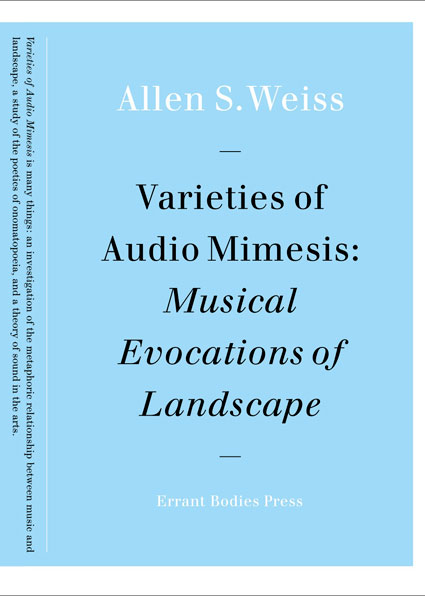Editions Errant Bodies
Les éditions Errant Bodies publient des livres (monographies, anthologies et essais), des DVD vidéo et des CD audio à l'avant-garde des musiques expérimentales, des arts sonores, des arts plastiques et de la performance, questionnant les pratiques du son et de l'espace dans leurs dimensions esthétique, socioculturelle et intellectuelle.
Elles ont été fondées par Brandon LaBelle en 1995.
(Errant Bodies publishes books, DVDs and CDs on sound art, auditory issues, contemporary political thought, and performative and spatial practices. As an independent press operating since 1995, Errant Bodies aims to support experimental work with a view toward nurturing cultural intervention and forms of critical reflection.)
Index des collections :
Anthologies
Audio Issues
Critical Ear
Records (CD/DVD)
Surface Tension
Liste des ouvrages (ensemble des collections) :
Heimo Lattner, A Voice That Once Was In One's Mouth, coll. Critical Ear, livre + CD, 2013
Maria Miranda, Unsitely Aesthetics – Uncertain practices in contemporary art, coll. Surface Tension, 2013
Serge Baghdassarians, Boris Baltschun, Bodybuilding, #08, coll. Records (CD/DVD), 2013
Jacqueline Caux, Almost Nothing with Luc Ferrari, coll. Critical Ear, 2013
Sophie Warren & Jonathan Mosley, Beyond Utopia, coll. Surface Tension, 2012
Christof Migone, Sonic Somatic : Performances of the Unsound Body, coll. Audio Issues, 2012
Brandon LaBelle et Claudia Martinho (sous la dir.), Site of Sound :
Of Architecture and the Ear Vol. 2, coll. Anthologies, livre + CD, 2011
Brandon LaBelle, Lecture on Nothing, #07, coll. Records (CD/DVD), 2011
Brandon LaBelle, The Sonic Body : Figures 1-12, #06, coll. Records (CD/DVD), 2011
Brandon LaBelle (sous le dir.) Manual for the construction of a sound
as a device to elaborate social connection, coll. Surface Tension, livre + CD, 2010
Brandon LaBelle, Radio Memory, coll. Audio Issues, livre + CD, 2008
Allen S. Weiss, Varieties of Audio Mimesis : Musical Evocations of Landscape, coll. Audio Issues, 2008
> retour au catalogue
Ouvrages détaillés :
A Voice That Once Was In One’s Mouth
Critical Ear Vol. 6 + CD, 2013
Heimo Lattner
(Critical Ear | édition anglaise)
Would it be a mistake to think that the concern to raise the voice has to do with a capacity that certain individuals have? Would it be a mistake to think that the inclination to speak up comes from a subject whose disposition is to doubt, query, be skeptical or be an inquisitive observer? Would it be a mistake to assume that the voice lies at the core of all social bonds?
This publication assembles six conversations recorded in Berlin between the artist Heimo Lattner and colleagues, focusing on the artist's research and practice. The conversations form a base for exposing key issues approached in Lattner's work, from Greek theater to city development, processes of displacement and gentrification to the re-interpretation and appropriation of cultural traditions, languages and ancient forms of communication and expression threatened by political and economical interests.
At the center of the conversations is the recurring theme of the voice, which Lattner's work queries as fundamental to issues concerning the formation of social and cultural identity. Lattner asks us to consider how the voice comes to carry contested meanings.
With Karolin Nedelmann, Moritz von Rappard, Judith Raum, Brandon LaBelle and Jassem Hindi.
Heimo Lattner is an artist working with film, video, performance, audio-play, room installation, installation and intervention in public space, drawing, cartography and writing. Since the late 90s he has also worked in the collective e-Xplo with Erin McGonigle and Rene Gabri, developing interventions in public space. Lattner is a founding member and co-operator of the project space General Public in Berlin. He is a guest lecturer at several universities in the fields of research-based art, public art and creative writing. He lives in Berlin.
Heimo Lattner, A Voice That Once Was In One's Mouth
(Critical Ear Vol. 6, 2013)
(textes en anglais)
14 x 21 cm / 174 pages, ill. n&b (broché) + CD
ISBN : 978-0-9827439-9-7
CHF 22,5 / EUR 17
(+ frais de port relatifs au pays de destination)

Unsitely Aesthetics – Uncertain practices in contemporary art
Surface Tension Supplement n° 06, 2013
Maria Miranda
(Surface Tension | édition anglaise)
In the last 10 years we have experienced a seismic shift in media culture, as the social media revolution of the noughties has brought vastly expanded networking, mobility and connection. This shift has significantly altered the making of art as well as the ways that audiences engage with art. Unsitely Aesthetics seeks to describe and understand these changes in art production and its accompanying new aesthetics, coining the term “unsitely” to point to the dispersed way that many artists are now making work across the networks both online and offline.
A departure point for the book is the idea that the traditional art historical term of site and site-specificity offers a new and strategic way to understand the shifting and troubled relationship of artwork and audience in network culture. This is a counterintuitive move against the sense of network culture as immaterial flows in a placeless world, thus underlining the situatedness of the making and experiencing of art that is still significant. The book suggests that with the unsitely aesthetics of today’s contemporary artists there is the possibility of a more democratic art with the internet acting as a public space for artists to encounter and even call forth new publics.
The book includes interviews and conversations with leading international artists and writers. Contributors: Barbara Campbell, Linda Carroli, Hugh Davies, Bec Dean, Renate Ferro, John Craig Freeman, Jo-anne Green, Teri Hoskin, Lucas Ihlein, Yao Jui-Chung, kanarinka (a.k.a. Catherine D’Ignazio), Scott Kildall, Deborah Kelly, Natalie Loveless, Michael Takeo Magruder, Timothy Conway Murray, Norie Neumark, Victoria Scott, Brooke Singer, Igor S¹tromajer, Helen Thorington, Darren Tofts.
Maria Miranda is an art-maker and art-researcher. She has maintained a collaborative art practice, Out-of-Sync, with Norie Neumark for over 15 years – making work that engages with questions of culture, place and memory. Currently she is Artistic Director of Gallery Ellipsis, the online gallery of the Centre for Creative Arts La Trobe University. From 2010 to 2012 Maria was a post-doctoral fellow at La Trobe University, Melbourne. Maria lives and works in Melbourne, Australia.
Maria Miranda, Unsitely Aesthetics – Uncertain practices in contemporary art
Surface Tension Supplement n° 06, 2013
(textes en anglais)
312 pages / 16,5 x 23 cm (broché)
ISBN : 978-0-9827439-8-0
CHF 29 / EUR 22
(+ frais de port relatifs au pays de destination)

Bodybuilding
#08, 2013
Serge Baghdassarians, Boris Baltschun
(Records [CD/DVD] | édition anglaise)
Berlin-based artists Serge Baghdassarians and Boris Baltschun retrace mathematician and astronomer Charles-Marie de La Condamine's journey to South America, though instead of the tropical wilderness, they’ve measured the urban jungle of Rio de Janeiro. Instead of compass and quadrant, their tools are microphone and recorder. What remains unchanged is the physical effort of exploring foreign terrain. On foot, and with an assortment of quasi-ritual exercises, the artists move from their residence in Rio to the triangular plaza Largo do Guimarães. At the end of their aural training session stands the ideal form of a place, an artificial sounding-body that seems strangely familiar in the way it further alienates the alien.
Serge Baghdassarians and Boris Baltschun have been collaborating since 1999 in the fields of sound installation and electronic music. Their work often focuses on the conception and realization of temporary as well as longtime installations that use mechanical means to realize an aesthetic inspired by electronic music. With references to outdated 19th century technology (lovers telegraph, steam engine f.e.) as well as computer controlled motor systems, a visualization of sonic phenomena is pursued. Of importance are also seemingly simple and minimal setups (well known, but appropriated materials), which produce complex results.
Serge Baghdassarians, Boris Baltschun, Bodybuilding
(♯08 Records [CD/DVD], 2013)
(textes en anglais)
13,5 x 18 cm (CD, affiche pliée et livret 16 pages)
59'29''
CHF 19 / EUR 14
(+ frais de port relatifs au pays de destination)
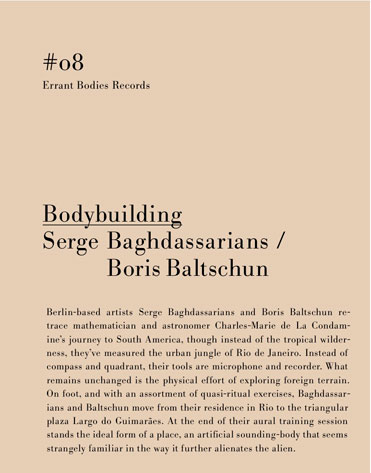
Almost Nothing with Luc Ferrari
Critical Ear Vol. 6, 2013
Jacqueline Caux
Interviews with texts and imaginary autobiographies by Luc Ferrari
(Critical Ear | édition anglaise)
Originally published in France in 2002, Jacqueline Caux’s Presque Rien avec Luc Ferrari is the first book to offer a comprehensive and insightful look into the work and career of one the most pioneering music composers of the second half of the 20th century. Errant Bodies Press is pleased to release the English edition translated by Jérôme Hansen.
True to the genre-defying career of Luc Ferrari, who passed away in 2005 at the age of 76, the book skilfully assembles original interviews conducted by the author with previously unpublished texts in which the composer reflects on some of his key works. The interviews are also interspersed with fourteen short "imaginary autobiographies", written from 1971 to 1997, and ranging from semi-factual accounts to more poetic, fictional, or even science-fictional pieces.
In her illuminating introduction, Jacqueline Caux starts by recounting some of the main achievements of this most libertarian, anti-dogmatic of artists, before identifying three constants throughout Ferrari’s tumultuous career: his passionate attention to the sounds of everyday life, his compositional use of chance and his emphasis on themes of intimacy and sensuality. In the first and more substantial chapter (History), musicologist François Delalande, composer Daniel Terrugi and musicologist Evelyne Gayou join the author to take Ferrari through his musical life, starting with his early years studying piano at the Conservatoire de Paris, where his teachers included Arthur Honegger and Olivier Messiaen. Tracing back his first encounter with fellow musique concrète pioneers Pierre Schaeffer and Pierre Henry, with which he would found the influential Groupe de Recherche Musicale (GRM), Ferrari offers a personal and richly evocative account of one of the most effervescent periods in modern music, culminating in the 1958 Brussels World’s Fair and the official recognition of a new generation of experimental composers: Varèse, Cage, Xenakis, Stockhausen. Another major shift in his career occurs with his discovery of the use of unprocessed everyday sounds, leading to what is perhaps his most famous work, Presque Rien (1969). This compositional strategy, for which he coined the characteristically understated term "anecdotal music", allowed him to bring the social into the musical vocabulary – a radical artistic move appropriate for these politically radical times. Chapter Two to Five successively address Ferrari’s involvement in a variety of mediums, from instrumental composition and music theater, to radio art and even installation art. In the final chapter (Concepts), Jacqueline Caux asks the composer to elaborate on some of the key concepts that have guided his work: anecdotal, autobiography, chance, heterogeneity, heterozygote, freedom, narration, tautology, etc. The book concludes with the complete list of his works as well as discography.
Jacqueline Caux, Almost Nothing with Luc Ferrari
(Critical Ear Vol. 6, 2013)
(textes en anglais)
16 x 21,5 cm / 176 pages, ill. n&b (relié, couv. toilée, marque-page ruban)
ISBN : 978-0-9827439-1-1
CHF 29 / EUR 22
(+ frais de port relatifs au pays de destination)
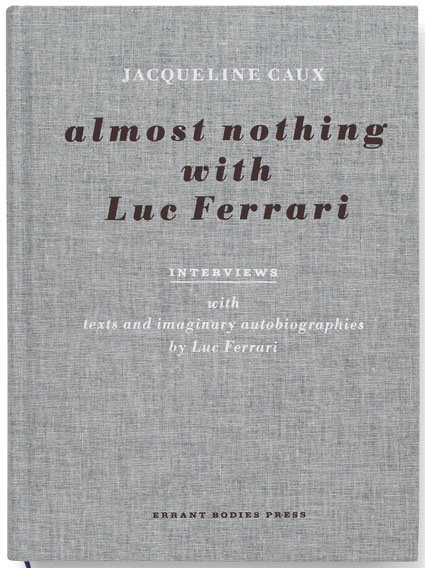
Beyond Utopia
Surface Tension Supplement n° 05, 2012
Sophie Warren & Jonathan Mosley
(Surface Tension | édition anglaise)
Based on a project initiated by the collaborative practice of Sophie Warren and Jonathan Mosley with writer Robin Wilson, Beyond Utopia queries the function of utopian thinking in urban planning and spatial culture.
The aim of the original project was to establish a critical dialogue with institutions of city design and to find new sites of productive tension between the “real” and the “fictional”. Submitting a utopian architectural proposal for a real site in London to the scrutiny of the institutions that dominate the design and programming of city space, the project enacted a form of playful provocation, drifting in and though the procedures, systems and languages of planning, architecture and city development. As a fiction, the utopian work gained life as it was recounted and discussed, its narrative shared, activated and engaged through dialogue with and by planning officials and reviewers.
Elaborating on the project, the publication Beyond Utopia aims to further provoke speculation, proposition and play, outlining the idea of “something missing” in the production of city space and urban relations. Including a screenplay produced by the artists, which restages the process and exchanges of the original proposal, the publication queries how we might actively resist restrictive canons of standardization to produce a specific sociability and emergent environment built collectively, spontaneously and in support.
Writers from various fields have been invited to fasten onto concepts raised in the screenplay, to develop their propositional nature and establish new grounds for speculation as to how to play utopia. The contributions both critique and contextualize utopian thinking, ultimately locating utopia as a critical tool with which to speculate and reveal the limits of our present urban condition and its systems.
The contributors include: Maria Fusco - writer and Director of Art Writing at Goldsmiths, London; Marie-Anne McQuay – curator; Paul O’Neill – curator, artist and writer; Elizabeth Price – artist; Jane Rendell – writer and Director of Architectural Research at the Bartlett, London; Lee Stickells – senior lecturer and researcher of architecture, University of Sydney; Robin Wilson – writer on architecture, art and landscape.
Sophie Warren is an artist and Jonathan Mosley is an architect. They have a critical spatial practice that employs strategies of play, hybridisation and the construction of imaginary architectures to resist homogeneous perceptions of urban space. Using language, event, still and moving imagery and installation Warren & Mosley construct situations, an informal architecture of possibility, moving between material fact and the fiction of the imagination. The practice infiltrates environments of the multi-use sports hall, the car park, the motorway service station, the construction site and the offices and corridors of the institutions that build our cities.
Their work has been exhibited internationally including the Showroom, London (2010) with Rogue Game an ongoing series of hybrid games in collaboration with Can Altay, Berlin 60th and 58th International Film Festivals (2010 and 2008), Sydney International Architecture Film Festival (2010), Crosstalk Video Festival, Budapest (2010), within Coalesce: Happenstance curated by Paul O’Neill at Smart Project Space, Amsterdam (2009), ITU Gallery, Istanbul (2008), Gymruy International Biennale, Armenia (2004), Centre of Contemporary Art, Glasgow (2003), The Armory Show, New York (2002), Frederike Taylor Gallery, New York (2001) and Gasworks, London (2000). Reviewed in the art and architectural press, the work of the collaboration has also been discussed in Jane Rendell (ed.) Critical Architecture (London: Routledge, 2007) and Brandon LaBelle (ed.) Surface Tension Supplement No.1 (Los Angeles and Berlin: Errant Bodies Press, 2006).
Sophie Warren & Jonathan Mosley, Beyond Utopia
Surface Tension Supplement n° 05, 2012
(textes en anglais)
126 pages / 18,5 x 24 cm, ill. n&b (broché)
ISBN : 978-0-9827439-3-5
CHF 25 / EUR 19
(+ frais de port relatifs au pays de destination)
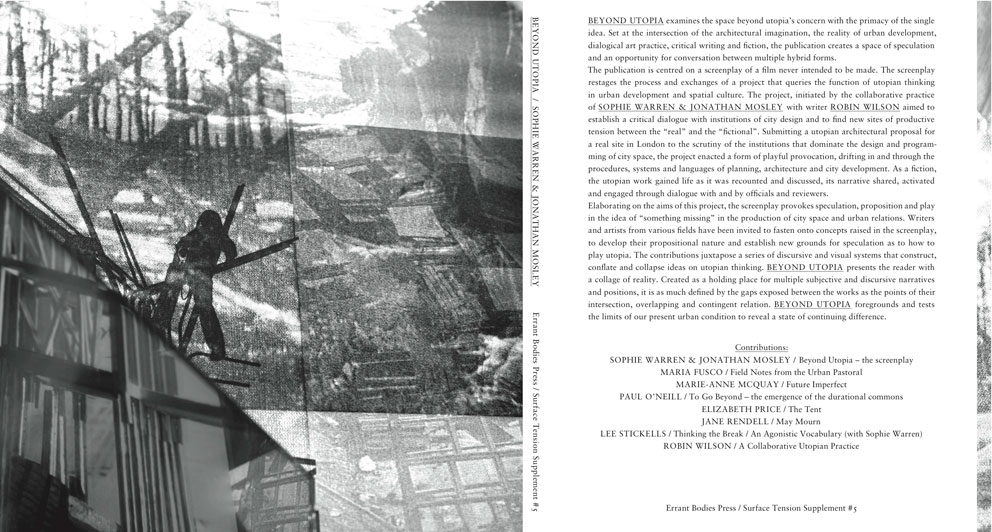
Sonic Somatic : Performances of the Unsound Body
Audio Issues, 2012
Christof Migone
(Audio Issues | édition anglaise)
This book delineates a territory of investigation for sound art and its various manifestations through historical, theoretical, polemical and critical analyses of artistic, musical and literary works. In doing so, Migone gives radical definition to an auditory study that includes the complexity of silence and mutism, identity and abjecthood, and language and its stutterances. The recurring site of these stagings is the somatic under all its forms: embodied and disembodied, fragmented and amplified, vocal and mute.
Concrete sites that are investigated include: Antonin Artaud’s writings, Alvin Lucier’s recording I am sitting in a room, Erik Satie’s composition Vexations, Marina Abramovic’s performance Rhythm 0, Adrian Piper’s Untitled Performance for Max’s Kansas City, Melville’s short story Bartleby, the Scrivener, Bob Connolly and Robin Anderson’s documentary film First Contact, and John Cage’s composition 4’33”.
Christof Migone is an artist, curator and writer. He obtained an MFA from the Nova Scotia College of Art & Design in 1996 and a PhD from the Department of Performance Studies at the Tisch School of the Arts of New York University in 2007. He currently is a Lecturer at the Department of Visual Studies and the Director/Curator of the Blackwood Gallery (University of Toronto).
Christof Migone, Sonic Somatic : Performances of the Unsound Body
(Audio Issues, 2012)
(textes en anglais)
16,5 x 22 cm / 296 pages, 52 ill. n&b (broché)
ISBN : 978-0-9827439-4-2
CHF 27,5 / EUR 21
(+ frais de port relatifs au pays de destination)
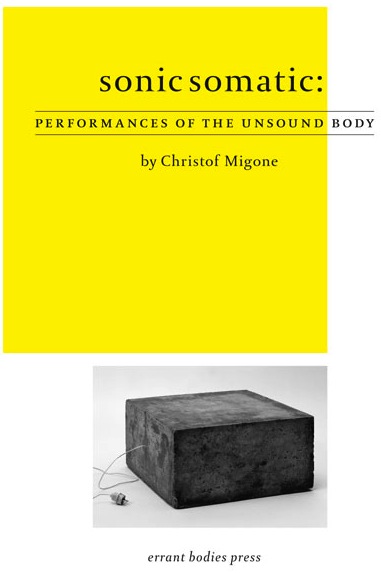
Site of Sound : Of Architecture and the Ear Vol. 2
Anthologies + CD, 2011
Brandon LaBelle et Claudia Martinho (sous la dir.)
(Anthologies | édition anglaise)
Since the publication of the first volume of Site of Sound in 1999 the issues and activities pertaining to sound and architecture have expanded to circulate more dynamically within the fields of sound art, sound design, and spatial practices. From acoustical technologies and urban planning to public art, concerns for auditory structures and the experiences of listening are finding deeper footing within both artistic and environmental contexts. Recent noise mappings across Europe, along with new possibilities for acoustical implementation, as well as the ongoing emergence of sound art and design educational programs, point toward sound as a crucial subject for thinking through contemporary culture and politics.
Site of Sound Vol. 2 aims to address contemporary work being done in the cross-over between sound and architecture. The anthology brings together new research and writing that charts out the theoretical implications and consequences for artistic and spatial discourses, while documenting contemporary projects that come to occupy and define a sonic-spatial territory.
With contributions by Justin Bennett, Usman Haque, David Schafer, James Webb, Edwin van der Heide, Raviv Ganchrow, Jodi Rose, Nigel Helyer, Michael Gendreau, Jean-Paul Thibaud, Tao G. Vrhovec Sambolec, Oliver Laric, David Stalling / Anthony Kelly, Romano, Natasha Barrett / Birger Sevaldson, Scott Arford / Randy Yau, Riccardo Benassi, Carrie Bodle, Jenny Pickett / Julien Ottavi, Pascal Broccolichi, Jacob Kreutzfeldt, Joaquín Gutiérrez Hadid, Franz Pomassl & Björn Quiring.
With accompanying CD of related audio.
Brandon LaBelle et Claudia Martinho (sous la dir.), Site of Sound : Of Architecture and the Ear Vol. 2
(Anthologies, 2011)
(textes en anglais)
17 x 24 cm / 304 pages, ill. couleur et n&b (broché, couv. à rabats) + CD
ISBN : 978-0-9827439-0-4
CHF 35 / EUR 27
(+ frais de port relatifs au pays de destination)

Lecture on Nothing
#07, 2011
Brandon LaBelle
(Records [CD/DVD] | édition anglaise)
Lecture on Nothing is a recording of John Cage’s original text as read by a deaf individual. According to Cage, silence may operate as a positive frame through which to appreciate non-musical sounds and to heighten the experience of listening: by integrating silence into his compositions, Cage sought to allow sounds of the world into the musical experience. Appropriating Cage’s text, this work aims to further explore silence as a complex signifier by giving us a voice that cannot hear itself. In doing so, the work multiplies perspectives onto the act of listening, and on the notion of being quiet. From an open space for renewed listening to forms of disciplinary power, silence and silencing can be heard to perform a complicated influence onto auditory culture.
Brandon LaBelle, Lecture on Nothing
(♯07 Records [CD/DVD], 2011)
(textes en anglais)
13,5 x 18,2 cm (CD, livret 32 pages)
54'50''
CHF 19 / EUR 14
(+ frais de port relatifs au pays de destination)

The Sonic Body : Figures 1-12
#06, 2011
Brandon LaBelle
(Records [CD/DVD] | édition anglaise)
Dancing recomposes music by pulling the beat, the melody, and the force of sonic experience the body to playback in excited gesture and movement. Extending the rapture of dance, The Sonic Body is a collection of the audible traces of dancing bodies. The movements of individuals listening to sound and music are recorded to form acoustic identities, highlighting dance as a form of translation: a heated musicology found in the step. The Sonic Body is a work that aims for the physicality of sound, as a process of ingestion, intake, a listening hunger, and finally, embodied reaction, a sensual vitality that refiguring bodily presence into an energetic micro-event.
Participants: Trine Hylander Friis, Annette Stahmer, Pedro Gómez Egaña, Bruno Lechowski, Martina Schaaf, James Webb, Signe Lidén, Tao G. Vrhovec Sambolec, Nicole Clarke, Eliza Pfister, Shayna Keller, Angelina Attwell, Gerald Michel, Natalie Hofmann, Anna Posch, Isis Martin, Steve Rowell, Priyanka Basu, Simone van Dijken, Hildur Gudnadottir and Baron Samedi.
Brandon LaBelle, The Sonic Body : Figures 1-12
(♯06 Records [CD/DVD], 2011)
(textes en anglais)
13,5 x 18,2 cm (CD, livret 16 pages)
52'
CHF 19 / EUR 14
(+ frais de port relatifs au pays de destination)
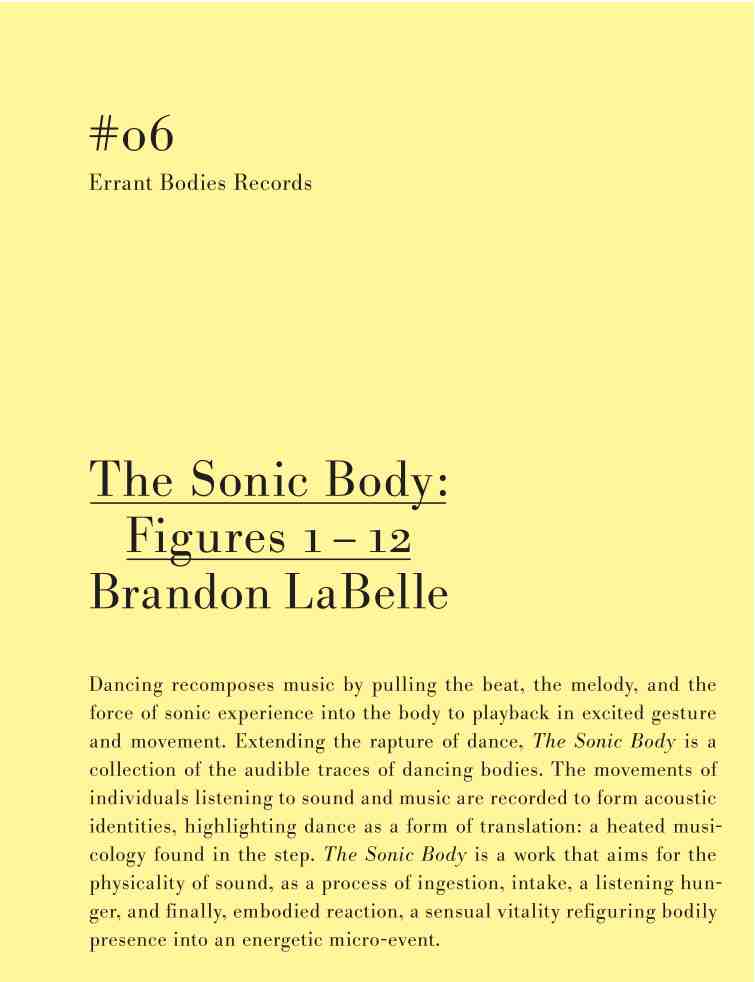
Manual for the construction of a sound as a device to elaborate social connection
Surface Tension Supplement n° 04, 2010
Brandon LaBelle (sous le dir.)
(Surface Tension | édition anglaise)
Organized as a temporary working group, the Manual project set out to explore sound and auditory experience as platforms for social meeting, urban intervention and environmental investigation. Developed in collaboration with Atelier Nord and the Ultima festival and staged in Oslo in 2009, the project brought together six artists from around Europe engaged in experimental media practices. The project functioned as a series of process-oriented field studies of the city, involving locational research, performative actions and public discussion. Such an approach aimed to use sound as a process of temporal and social exchange. The works involved supplemented objective perspectives with face-to-face interactions, secret interventions, and transmissions so as to bring forward amplifications of city life.
Including artistic works and materials by Siri Austeen (Norway), Brandon LaBelle(US/Germany), Tao G. Vrhovec Sambolec (Slovenia/Holland), Kristina Lindström & Åsa Ståhl (Sweden), and Jana Winderen (Norway).
Further essay contributions by curators and philosophers Federica Bueti, Sophie Gosselin & David gé Bartoli, Mike Harding and Stine Hebert.
Each book includes one of five produced CDs by the participating artists.
Brandon LaBelle (sous le dir.), Manual for the construction of a sound as a device to elaborate social connection
Surface Tension Supplement n° 04 + CD, 2010
(textes en anglais)
104 pages / 18,5 x 24 cm, 62 ill. couleur (broché) + CD
ISBN : ISBN: 978-0-9772594-8-9
CHF 25 / EUR 19
(+ frais de port relatifs au pays de destination)
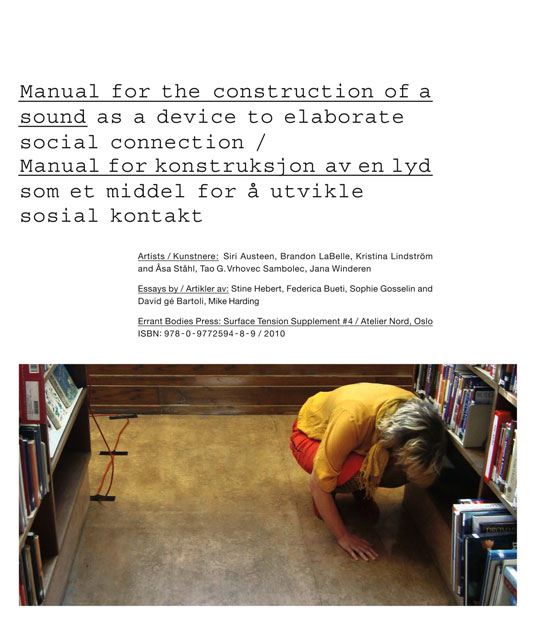
Radio Memory
Audio Issues Vol. 4 + CD, 2008
Brandon LaBelle
(Audio Issues | édition anglaise)
Radio makes an impression, casting songs far and wide to end up on innumerable receivers, within countless ears. This instant of reception inserts a soundtrack to physical location and the encounters happening, intensifying music’s ability to give emotional charge: a sound in the distance, playing on a stranger’s ghetto blaster, or traveling from an open window, across a city street, to arrive at the moment to become forever associated with a certain happening, where song and event are fused, inseparable.
Inviting people from around the world to send in their radio memories — of songs overheard at special moments in their lives — Radio Memory is a collection of stories revealing highly personal experiences that in turn speak toward a larger cultural picture. Are such memories partially created by the songs themselves, rather than being strictly supplements to them? In what way does radio play a part in leaving marks on the psyche? And what may a catalogue of radio memories reveal about the musical landscape ?
Cataloguing the memories, Radio Memory is an artist project by Brandon LaBelle. Initiated in 2005 and continuing today, the book documents the artist’s related installations, along with a CD of new work, making a small testament to the power of transmission. Including additional contributions by curator and theorist Bastien Gallet and Carmen Cebreros Urzaiz.
Brandon LaBelle, Sonic Somatic : Performances of the Unsound Body
(Audio Issues Vol. 4, 2008)
(textes en anglais)
16 x 21 cm / 128 pages, 25 ill. coul. (broché, couv. en affiche pliée) + CD
ISBN : 978-0-9772594-6-5
CHF 23 / EUR 17
(+ frais de port relatifs au pays de destination)
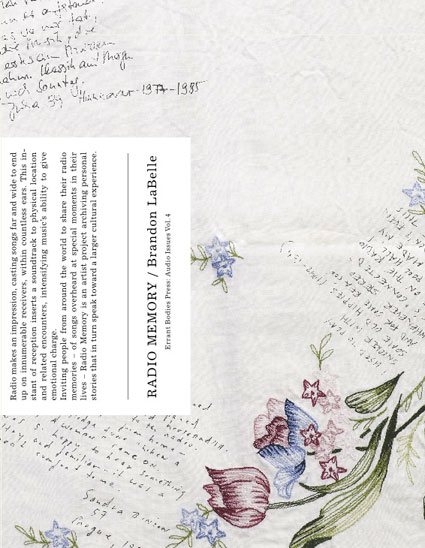
Varieties of Audio Mimesis : Musical Evocations of Landscape
Audio Issues, 2008
Allen S. Weiss
(Audio Issues | édition anglaise)
The history of European musicology is perennially revised around the central ontological debate about whether music is a representational or an abstract art. This discussion may be extended to all of the sound arts. Thus the minor poetic phenomenon of onomatopoeia is emblematic of what might be seen as the ontological aporia of sound art (and by extension of all representation): mimesis is simultaneously a loss and a gain, placing representation on uneven ground where the signified loses structural integrity and existential verifiability, while the signifier gains in complexity and ambiguity. Through literary, performative, and sonic analysis, this book simultaneously serves as a tool for investigating the micro-structures of audiophonic representation; proposes a unified, though open-ended, field theory of the sound arts; offers expanded descriptive possibilities for audio productions; and revises the study of audio mimesis in relation to gardens and landscape.
Allen S. Weiss is a theorist, editor, translator, curator, playwright who has authored and edited over 35 books in the fields of performance theory, landscape architecture, gastronomy, and literary studies, including Phantasmic Radio (1995) and Breathless: Sound Recording, Disembodiment, and the Transformation of Lyrical Nostalgia (2002). He directed Theater of the Ears (a play for electronic marionette and taped voice based on the writings of Valère Novarina), and Danse Macabre (a marionette theatre with the dolls of Michel Nedjar). He teaches in the Departments of Performance Studies and Cinema Studies at the Tisch School of the Arts of New York University.
Allen S. Weiss, Varieties of Audio Mimesis : Musical Evocations of Landscape
(Audio Issues, 2008)
(textes en anglais)
14,2 x 19,5 cm / 112 pages, 2 ill. coul. sur feuilles insérées (broché sous jaquette)
ISBN : 978-0-9772594-4-1
CHF 23,5 / EUR 18
(+ frais de port relatifs au pays de destination)
